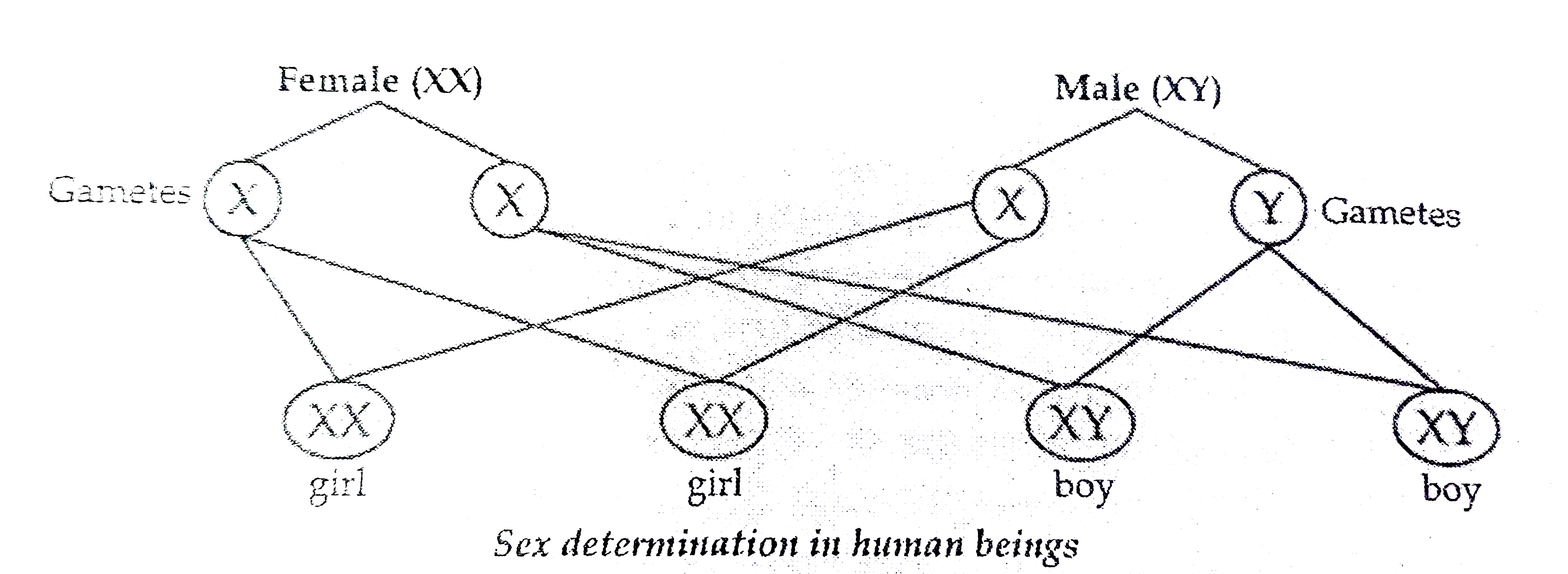"The sex of a newborn child is a matter of chance and none of the parents may be considered responsible for it." Justify this statement with the help of a flow chart showing determination of sex of a newborn.
Sex determination flow chart:
(i) A male has one X- chromosome and one Y-chromosome. Thsu half the male gametes have X-chromosomes and the other half have Y-chromosomes.
(ii) A female has two X-chromosomes. Thus all female gametes have only X-chromosomes.
(iii) If a sperm carrying Y-chromosome fertilises an ovum carrying X-chromosome, then the child born will be a boy.
(iv) If a sperm carrying X-chromosome fertilises an ovum carrying X-chromosome, then the child born will be a girl.

Therefore it is the sperm from the father which determines the sex of the child.
Thus in human geings, the sex of the baby is determined by the type of sperm that fuses with ovum. As human male produces two types fo sperms in equal proportion, so there are 50% chances of a male baby and 50% chances of a female baby.
Topper's Solved these Questions
- X BOARDSBOOK - X BOARDSCHAPTER - X BOARDSEXERCISE - SET-I SECTION-A
1 Videos
- X BOARDSBOOK - X BOARDSCHAPTER - X BOARDSEXERCISE - SET-I SECTION-B
1 Videos
- X BOARDSBOOK - X BOARDSCHAPTER - X BOARDSEXERCISE - SET III (SECTION -D)
2 Videos
- QUESTION PAPER 2023BOOK - X BOARDSCHAPTER - QUESTION PAPER 2023EXERCISE - Question
24 Videos
Similar Questions
(a) What are homologous structures? Give an example.
(b) "The sex of a newborn child is a matter of chance and none of the parents may be considered responsible for it." Justify this statement with the help of a flow chart showing sex-determination in human beings.
View SolutionWith the help of a flow diagram, how would you establish that in human beings the sex of a newborn is purely a matter of chance and none of the parents may be considered responsible for a particular sex of a newborn child.
View Solution
Knowledge Check
Who is responsible for the sex determination of a child
AFatherBMotherCBoth mother and fatherDNone of theseRead the passage given below and answer the questions that follow :
The difference in the ways of thinking and perception in the people of two different generations, which results in behavioural differences and sometimes conflict among them, is usually called generation gap. Generation gap is generally seen in the family between parents and their children. It is not only because of the gap in age, but also because of the way parents react to a particular situation. Children being very young and immature do not understand the way of thinking of their parents. In many cases, the parents, even if they are matured, do not empathize with the changing values and thinking pattern of the modern world. This creates a communication gap between these two generations.
Generation gap between parents and children is mostly caused by parents themselves. They do not talk openly to their children and do not take part in solving their problems. This behaviour gives the impression about parents being authoritative persons, because they only dictate without understanding the problems faced by their children. As a result, the children become mentally isolated from their parents. Some parents become so busy with their work that they don't spend quality time with their families, which makes them completely unaware of how their children are growing, what kind of mentality is being developed in them, and so on. This ultimately creates a gap between them. They only realize it when it is too late.
Changes in technology have led to the generation gap in this modern world. Children tend to spend most of their time with their digital devices and are so busy with social media, that they do not discuss their problems with their parents. The internet provides solutions to most of the worldly problems. So children, instead of contacting their own parents, seek the help of internet in case of any problem, thus again reducing the communication, leading to a generation gap between them. The generation gap has greatly increased these days because the time is changing fast and people find it difficult to cope up with this change. To overcome this problem, parents should show interest in all matters of their children and deal with them positively, instead of just scolding them and leaving them alone to deal with their problems. Giving time to the children, having open communication, and allowing the child to feel free and remain free from pressure, will eventually reduce the generation gap to a tolerable extent.
What causes the gap between the parents and their children?ADifference in the ways of thinkingBMisunderstandingCImmaturity on the part of childrenDAll of the above
With the help of a chart, explain the method of sex determination in honeybees.
View Solution"Only father is responsible for the sex of a new born child." Explain with the help of a neat illustration.
View SolutionHow many pairs of chromosomes are present in human beings ? Out of these how many are sex chromosomes ? How many types of sex chromosomes are found in human beings ? "The sex of a new born child is a matter of chance and none of the parents may be newborn to justify this statement.
View SolutionIn humans, there is a 50% probability of the birth of a boy and 50% probability that a girl will be born. Justify the statement on the basis of the mechanism of sex-determination in human beings.
View SolutionState whether the following statements are true or false :It is the sperm which determines the sex of a child.
View Solution(a) "Use of a condom is beneficial for both the sexes involved in a sexual act." Justify this statement giving two reasons.
(b) How do oral contraceptive help in avoiding pregnancies?
(c ) What is sex selective abortion? How does it affect a healthy society. (State any one consequence)
View Solution
